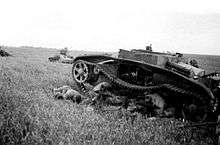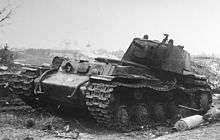Jack-in-the-box effect


The jack-in-the-box effect refers to a specific effect of a catastrophic kill on a tank or other turreted armored vehicle in which an ammunition explosion causes the tank's turret to be violently blown off the chassis and into the air. It is named after the child's toy, the jack-in-the-box, in which a puppet pops up.
Mechanics
If an anti-tank projectile or shaped-charge blast manages to penetrate a turreted armored vehicle's hull and subsequently its ammunition storage area, the shock wave or heat and pressure can be sufficient to cause cooking off or sympathetic detonation of the tank's entire load of unfired explosive shells and propellant. This causes a massive and instantaneous overpressure in the sealed internal compartment of the tank, until it explodes outwards through the weakest point in the otherwise homogeneous compartment, namely the turret ring, blowing the turret completely off the chassis and into the air in a gout of flame.
The jack-in-the-box effect is only known to occur in tanks which are "buttoned-up" (i.e. with all hatches closed and locked), and which have internally stored ammunition and no blow-off panels on the ammunition storage area. Tanks of the World War II era were frequently seen to have lost their turrets in this manner, largely owing to poor design (most designers had not yet recognized the need for special shielding of the ammunition storage compartments of tanks.). Many modern tanks (for instance, the M1 Abrams, Leopard 2, Challenger 2 and Leclerc series, to name a few) feature ammunition compartments designed to fail safely under fire as a firepower kill—when damaged, vents open to channel ignited propellants and explosives away from the crew cabin. The intact crew can then return the tank to a maintenance center or, at least, escape their disabled vehicle.
References
- The Eve of Destruction: The Untold Story of the Yom Kippur War, Howard Blum, Harper Perennial, 2004
- Tanks of World War II; Jane's Information Group, HarperResource, 1995
- Jane's Tank Recognition Guide, Christopher F. Foss and Jane's Information Group, Harper-Collins Publishers, 2003
